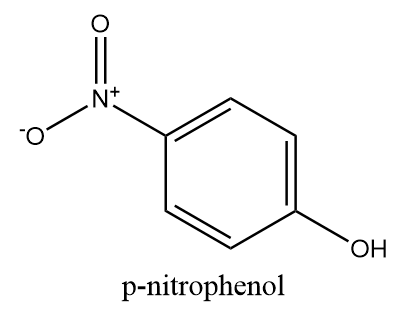
Which of the following compounds show intramolecular hydrogen bonding?
A. o-nitrophenol
B. p-nitrophenol
C. phenol
D. salicylaldehyde
1. A and B
2. A and C
3. A and D
4. B and C
Answer
506.4k+ views
Hint: A special type of dipole-dipole interactions between hydrogen atoms and the highly electronegative elements i.e., fluorine, oxygen and nitrogen are known as hydrogen bonding. It is of two types, intermolecular hydrogen bonding and intramolecular hydrogen bonding.
Complete answer: Intramolecular hydrogen bonding: It is a type of hydrogen bonding in which the dipole-dipole interactions are observed within a single molecule. This usually occurs when two functional groups consisting of hydrogen atoms and an electronegative element are located very near to each other in a compound. Intramolecular hydrogen bonding is stronger than intermolecular hydrogen bonding because all the groups participating in hydrogen bonding are connected via covalent bond to the same molecule.
Among the given options,
o-nitrophenol: The structure of ortho nitrophenol is as follows:

As the nitro group and the hydroxyl group are present very near to each other i.e., at adjacent positions, so the hydrogen atom of hydroxyl group will form a dipole interaction with the oxygen atom of nitro group and hence, it will show intramolecular hydrogen bonding. The interactions will be as follows:

p-nitrophenol: The structure of para nitrophenol is as follows:

As the nitro group is present at the opposite position to that of hydroxyl group so there is no possibility of dipole-dipole interaction in the molecule and hence, it will not show intramolecular hydrogen bonding.
Phenol: The structure of phenol is as follows:

As there is no other functional group present with which it can show dipole interactions. So, phenol will not show intramolecular hydrogen bonding.
Salicylaldehyde: The structure of salicylaldehyde is as follows:

As the aldehyde group and the hydroxyl group are present very near to each other i.e., at adjacent positions, so the hydrogen atom of hydroxyl group will form a dipole interaction with the oxygen atom of aldehyde group and hence, it will show intramolecular hydrogen bonding. The interactions will be as follows:

Hence, only compounds A and D will show intramolecular hydrogen bonding. Thus, option (3) is the correct answer.
Note:
It is important to note that the hydrogen bonding will exist between those atoms which are not covalently bonded to each other. For example, in a water molecule, the hydrogen atom shows intermolecular hydrogen bonding with the oxygen atom of the other molecule of water, not within the same molecule.
Complete answer: Intramolecular hydrogen bonding: It is a type of hydrogen bonding in which the dipole-dipole interactions are observed within a single molecule. This usually occurs when two functional groups consisting of hydrogen atoms and an electronegative element are located very near to each other in a compound. Intramolecular hydrogen bonding is stronger than intermolecular hydrogen bonding because all the groups participating in hydrogen bonding are connected via covalent bond to the same molecule.
Among the given options,
o-nitrophenol: The structure of ortho nitrophenol is as follows:

As the nitro group and the hydroxyl group are present very near to each other i.e., at adjacent positions, so the hydrogen atom of hydroxyl group will form a dipole interaction with the oxygen atom of nitro group and hence, it will show intramolecular hydrogen bonding. The interactions will be as follows:

p-nitrophenol: The structure of para nitrophenol is as follows:

As the nitro group is present at the opposite position to that of hydroxyl group so there is no possibility of dipole-dipole interaction in the molecule and hence, it will not show intramolecular hydrogen bonding.
Phenol: The structure of phenol is as follows:

As there is no other functional group present with which it can show dipole interactions. So, phenol will not show intramolecular hydrogen bonding.
Salicylaldehyde: The structure of salicylaldehyde is as follows:

As the aldehyde group and the hydroxyl group are present very near to each other i.e., at adjacent positions, so the hydrogen atom of hydroxyl group will form a dipole interaction with the oxygen atom of aldehyde group and hence, it will show intramolecular hydrogen bonding. The interactions will be as follows:

Hence, only compounds A and D will show intramolecular hydrogen bonding. Thus, option (3) is the correct answer.
Note:
It is important to note that the hydrogen bonding will exist between those atoms which are not covalently bonded to each other. For example, in a water molecule, the hydrogen atom shows intermolecular hydrogen bonding with the oxygen atom of the other molecule of water, not within the same molecule.
Recently Updated Pages
The number of solutions in x in 02pi for which sqrt class 12 maths CBSE

Write any two methods of preparation of phenol Give class 12 chemistry CBSE

Differentiate between action potential and resting class 12 biology CBSE

Two plane mirrors arranged at right angles to each class 12 physics CBSE

Which of the following molecules is are chiral A I class 12 chemistry CBSE

Name different types of neurons and give one function class 12 biology CBSE

Trending doubts
Which are the Top 10 Largest Countries of the World?

What are the major means of transport Explain each class 12 social science CBSE

Draw a labelled sketch of the human eye class 12 physics CBSE

Differentiate between insitu conservation and exsitu class 12 biology CBSE

The computer jargonwwww stands for Aworld wide web class 12 physics CBSE

State the principle of an ac generator and explain class 12 physics CBSE




